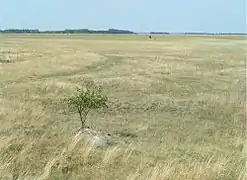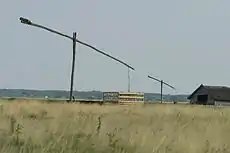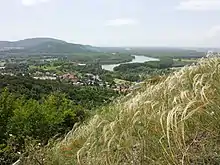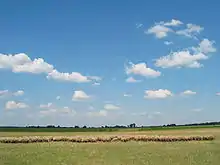Pannonian Steppe
The Pannonian Steppe[1] is a variety of grassland ecosystems[2] found in the Pannonian Basin. It is an exclave of the Great Eurasian Steppe, found in modern-day Austria, Bulgaria, Hungary, Romania, Serbia and Slovakia.[3]


Name
In Hungary it is known as Puszta (Hungarian pronunciation: [ˈpustɒ]). The word Puszta means "plains", a vast wilderness of shrubs and grassland. The name comes from an adjective of the same form, meaning "waste, barren, bare". Puszta is ultimately a Slavic loanword in Hungarian (compare Serbo-Croatian and Bulgarian pust and Polish pusty, both meaning bare or empty).
Geography
The Pannonian Steppe is an exclave of the Eurasian Steppe. The climate is continental.
The part of the Pannonian Steppe in Hungary is a grassland biome[4] on the Great Hungarian Plain (Alföld) around the River Tisza in the eastern part of Hungary as well as on the western part of Hungary and in the Austrian Burgenland. The landscape has been widely cultivated and the original landscape is now found only in a few places, for example in Hortobágy National Park. The characteristic landscape is composed of treeless plains, saline steppes and salt lakes, and includes scattered sand dunes, low, wet forests and freshwater marshes along the floodplains of the ancient rivers.[5]About three hundreds species of birds can be found here.[5]
The Čenkovská steppe near Mužla is the only steppe National nature reserve in Slovakia. The protected area declared in 1951 covers a total of 83 hectares.[6][7]

Apart from the Čenkovská forest-steppe, other notable steppe and forest-steppe biomes in Slovakia are located mostly around the Danubian and East Slovak plains and the southern ranges of the Pramatra system. Two of the biomes are Devínska Kobyla and the Slovak Karst (connects to Aggtelek in Hungary).[8][9][10]
The part of the Pannonian steppe in Austria is present in Burgenland mainly around Lake Neusiedl.[11]
References
- Természettudományi Múzeum (Hungary), 1969. link: https://books.google.sk/books?id=cOrRAAAAMAAJ&q=%22pannonian+steppe%22+pannonian+basin&dq=%22pannonian+steppe%22+pannonian+basin&hl=sk&sa=X&ei=i9s0T_OeF8uQswaBlOigDA&redir_esc=y
- http://www.steppe.at/downloads/Tschechien_nurText.pdf
- The European Commission (DG ENV B2) commissioned the Management of Natura 2000 habitats, 2008. http://ec.europa.eu/environment/nature/natura2000/management/habitats/pdf/6260_Pannonic_sand_steppes.pdf ISBN 978-92-79-08328-0
- Ward Chesworth, Encyclopedia of Soil Science, Springer, 2008, p. 66
- Peter Haggett, Encyclopedia of World Geography: Eastern Europe, p. 1781
- Informačný portál rezortu MŽP SR. http://uzemia.enviroportal.sk/main/detail/cislo/22 Slovak Environmental Agency, 2012
- "Archived copy". Archived from the original on 2012-08-04. Retrieved 2012-02-23.CS1 maint: archived copy as title (link) Foruminstitut 2011
- http://www.saske.sk/cave/slk/slkfaun.html
- "Archived copy". Archived from the original on 2007-07-02. Retrieved 2012-03-22.CS1 maint: archived copy as title (link)
- "Archived copy". Archived from the original on 2012-05-18. Retrieved 2012-03-22.CS1 maint: archived copy as title (link)
- "Archived copy". Archived from the original on 2011-08-05. Retrieved 2012-03-09.CS1 maint: archived copy as title (link)

